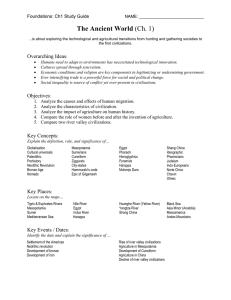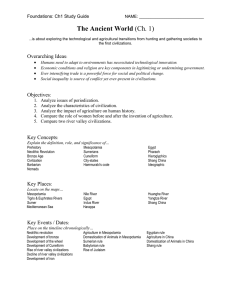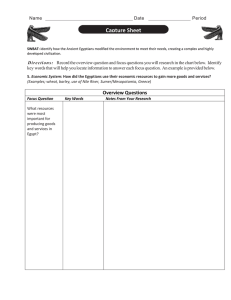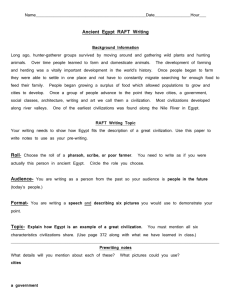Prehistory – River Valley Civilizations (
advertisement
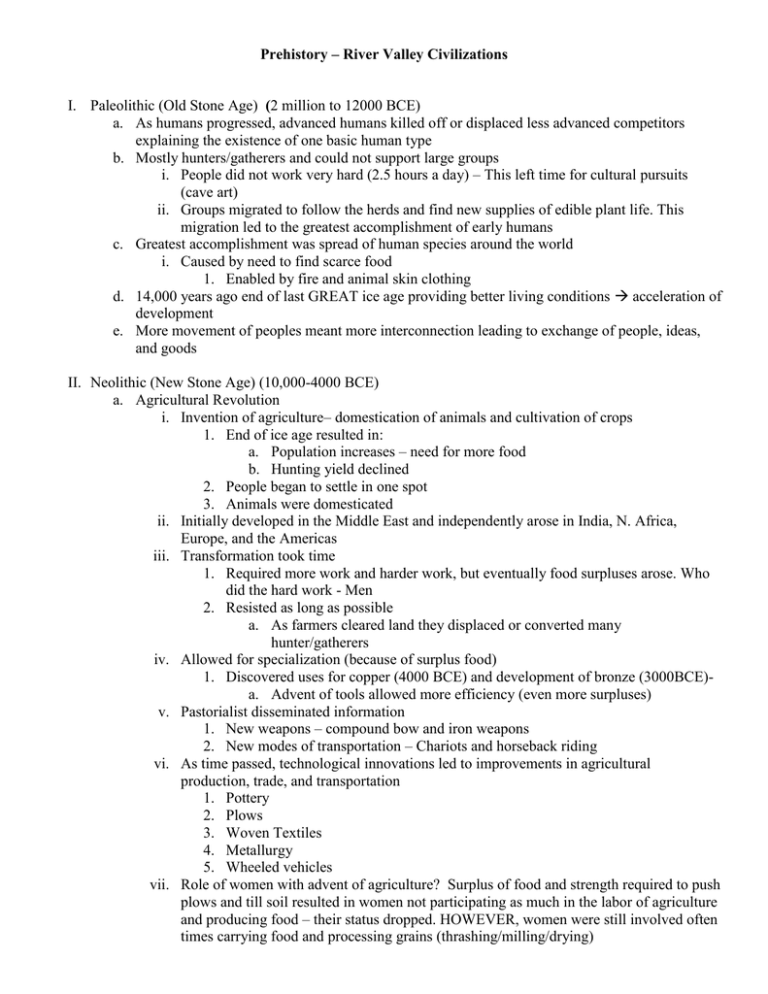
Prehistory – River Valley Civilizations I. Paleolithic (Old Stone Age) (2 million to 12000 BCE) a. As humans progressed, advanced humans killed off or displaced less advanced competitors explaining the existence of one basic human type b. Mostly hunters/gatherers and could not support large groups i. People did not work very hard (2.5 hours a day) – This left time for cultural pursuits (cave art) ii. Groups migrated to follow the herds and find new supplies of edible plant life. This migration led to the greatest accomplishment of early humans c. Greatest accomplishment was spread of human species around the world i. Caused by need to find scarce food 1. Enabled by fire and animal skin clothing d. 14,000 years ago end of last GREAT ice age providing better living conditions acceleration of development e. More movement of peoples meant more interconnection leading to exchange of people, ideas, and goods II. Neolithic (New Stone Age) (10,000-4000 BCE) a. Agricultural Revolution i. Invention of agriculture– domestication of animals and cultivation of crops 1. End of ice age resulted in: a. Population increases – need for more food b. Hunting yield declined 2. People began to settle in one spot 3. Animals were domesticated ii. Initially developed in the Middle East and independently arose in India, N. Africa, Europe, and the Americas iii. Transformation took time 1. Required more work and harder work, but eventually food surpluses arose. Who did the hard work - Men 2. Resisted as long as possible a. As farmers cleared land they displaced or converted many hunter/gatherers iv. Allowed for specialization (because of surplus food) 1. Discovered uses for copper (4000 BCE) and development of bronze (3000BCE)a. Advent of tools allowed more efficiency (even more surpluses) v. Pastorialist disseminated information 1. New weapons – compound bow and iron weapons 2. New modes of transportation – Chariots and horseback riding vi. As time passed, technological innovations led to improvements in agricultural production, trade, and transportation 1. Pottery 2. Plows 3. Woven Textiles 4. Metallurgy 5. Wheeled vehicles vii. Role of women with advent of agriculture? Surplus of food and strength required to push plows and till soil resulted in women not participating as much in the labor of agriculture and producing food – their status dropped. HOWEVER, women were still involved often times carrying food and processing grains (thrashing/milling/drying) III. Civilization – Is the term Civilizations a synonym for good? a. For each of the following words, tell me whether or not they are representative of civilized peoples: i. Gender inequality ii. Slavery iii. Warlike iv. Divisions in social-class – have/have nots v. Diseases vi. Ruler and ruled vii. Destruction of environment 1. All of these are characteristics of civilizations b. Why Civilization? i. Need groups of people to create and maintain irrigation devices to channel river water to fields c. What defines a civilization? i. Must contain all of the following: 1. Reliable Surpluses 2. Division of Labor / Specialization / Monumental Building 3. Cities 4. Central government – Bureaucrats 5. Social Classes 6. Trade – often long distance 7. Writing/Literacy – must keep records a. Scholars still debate the “true” definition IV. Characteristics of River Valley Civilizations a. The Big 4 and the Americas i. Mesopotamia (Tigris and Euphrates) ii. Egypt (Nile) iii. India (Indus) iv. China (Hwang He/Yellow River) v. Chavin vi. Olmecs 1. Favorable Locations led to a growing population which then leads to territorial expansion a. Example: Hittites in Mesopotamia b. Mesopotamia, China and the Americas developed independently, but Egypt and India borrowed ideas learned from trading i. Despite borrowing ideas and technology, each developed a distinctive society and culture c. Similarities i. Use of metals and other technology to aid farming and warfare ii. Monumental Building – ziggurats, pyramids, temples, defensive walls, streets, sewage and water systems iii. Arts promoted by religious and political elites – sculpture, paintings, literature iv. Creation of a writing system – exception is Andean civilizations – Quipu for record keeping v. Trade expanded from local to regional and trans-regional 1. Egypt and Nubia 2. Mesopotamia and the Indus Valley vi. Complex political structures with ruler who was believed to be divine or had divine support and was supported by military V. vii. Creation of legal codes – Code of Hammurabi viii. Religion 1. Vedic religion 2. Hebrew monotheism 3. Zoroastriaism d. Differences i. Egyptian economy was more government directed than Mesopotamia ii. Mesopotamia science and writing was more advanced than Egypt, but Egypt had superior mathematics iii. All created their own distinctive alphabets iv. Egypt had great monumental buildings (pyramids) while China did not v. Chinese developed an elaborate intellectual life while the others did not e. Decline of civilizations i. Most were in decline by 1000 BCE 1. Often due to invasion ii. Left a mark created a diverse array of regional identities Conclusion a. River Valleys created a basic set of tools, intellectual concepts such as writing and mathematics, and political forms that would persist and spread b. Civilization created a division among the world’s peoples but trade led to a major theme in world history: Increasing contacts battling an often fierce local identity c. 4 major shared commonalities: cities, trade and writing; but the values or belief systems were often radically different (political attitudes, beliefs about death and artistic styles)
